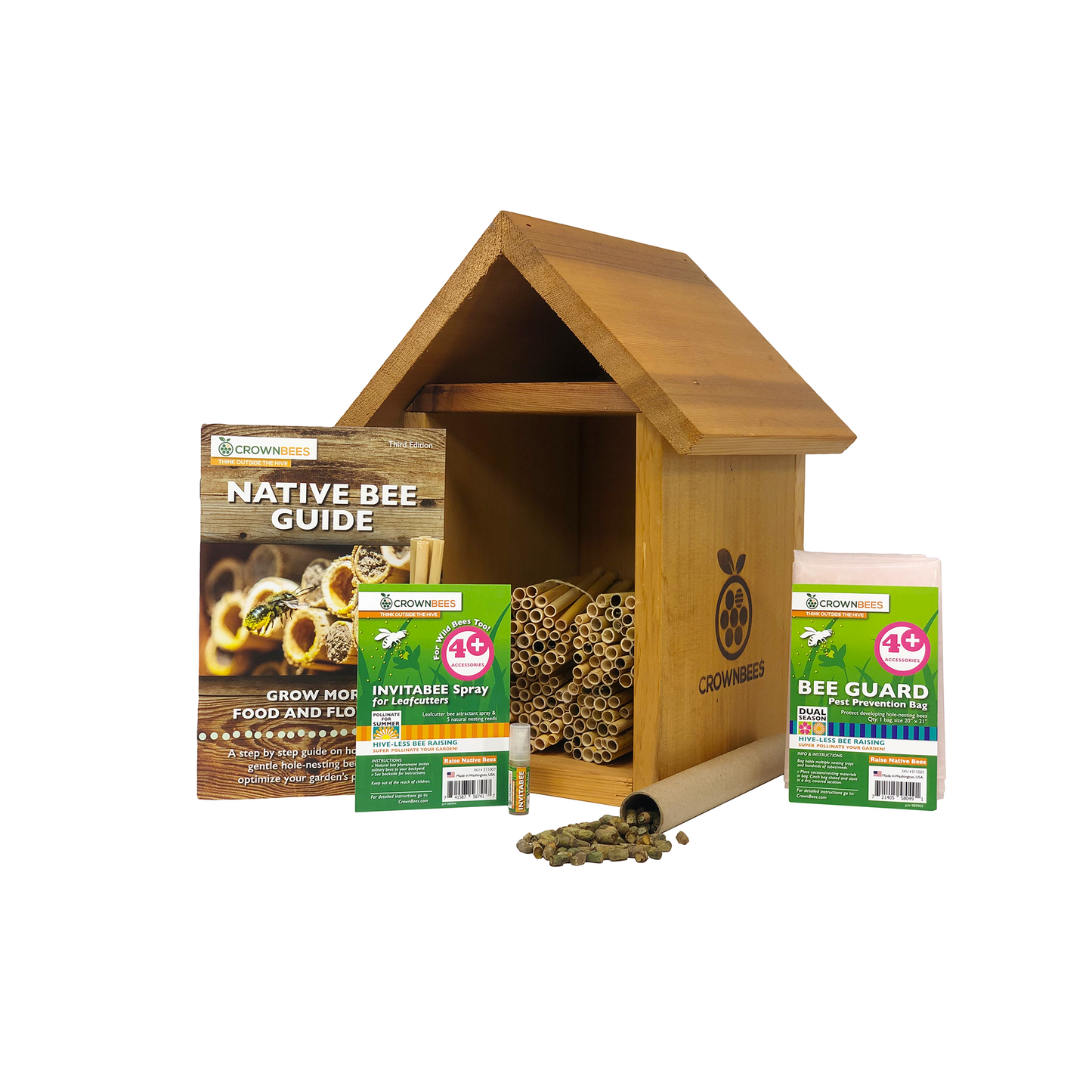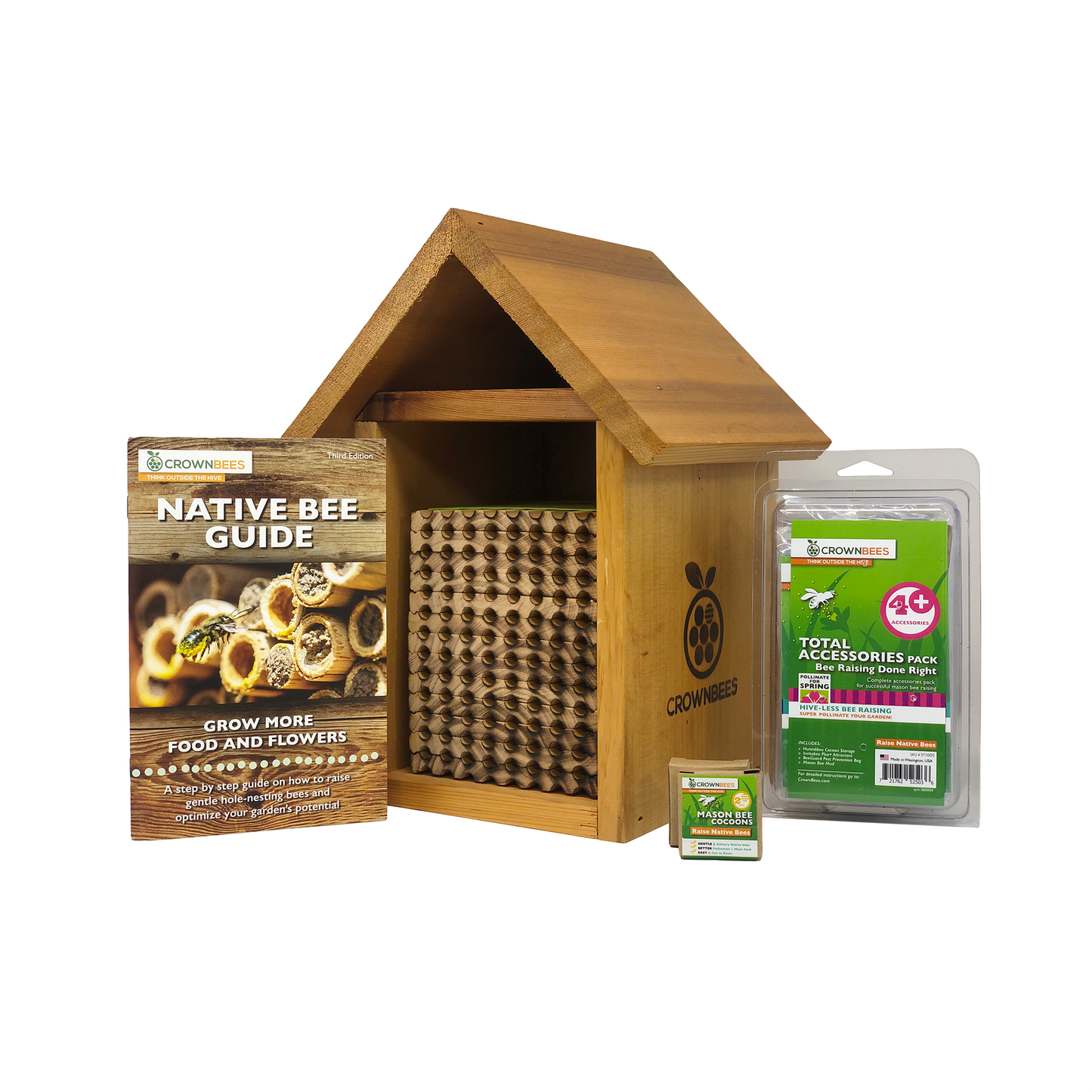
Before you release your mason bee cocoons, you'll want to make sure your yard and garden are ready for these super spring pollinators!
Need a little help remembering what to do when? Sign up for BeeMail and we'll send timely information, reminders, and tips to your email to help guide you along your solitary bee-raising journey!
What You Will Need:
1. Bee House or Hotel
A sturdy bee house or hotel mounted to a solid object (like a post, home, or fence) is the foundation of safe nesting habitat. Solitary bees and wasps prefer a house that protects from the wind, rain, and, if necessary, birds.
- Orientation: Bees are cold-blooded and need the warmth of the morning sun to get started. Select a site that is south to southeast facing.
- Location: Install the bee house on a sturdy wall, fence, or post -bees do not like swinging in the breeze. Mason bees only fly about 300ft (100m), searching for nectar and pollen, so place the house near open blooms.
- Height: At eye level, about 5ft (1.5m) off the ground to protect the bees from small predators, like mice or ants. Plus, these bees are fun to watch!
- Bird Protection: If needed, choose bird wire or hardwire cloth with 3/4" openings and loosely create a 2" bubble around the front of the house. Do not install the wire flush against the nesting materials, as this can also prevent bees from accessing the nests. Check out our All-Season Pests and Predators of Cavity-Nesting Bees to learn more about bird protection.

2. Cocoon Protection
The bee house should provide a little spot for the cocoons to emerge and a 2-3" roof overhang to protect the cocoons from the birds, sun, wind, and rain.
All Crown Bees houses will have either have a cocoon hatchery built into the design or an open area to place an individual cocoon hatchery.

3. Bee-Safe Nesting Materials
Cavity-nesting bees and wasps are of various sizes, and each species has a preferred nesting diameter. Spring mason bees prefer nesting materials that are ~8mm in diameter.
Nesting materials sealed at one end, breathable, thick-walled, and easily opened are the best way to protect bees from pathogens and parasites such as excessive mold, chalkbrood, parasitic wasps, and pollen mites.
All of our Spring Mason Bee Nesting Materials meet these requirements!
Check out our Bee-Safe Nesting Materials article to learn more about the best practices when it comes to nesting materials.

What Your Yard and Garden Will Need:
1. Clay-Rich Mud Source
Mud is vital for mason bee reproduction, and females will not nest if they do not have a reliable source nearby (within 25 - 50 ft.). However, not just any mud will do! Mason bees prefer to use mud with a high clay content or the consistency of modeling clay. Damp mud with a high clay content allows the female to mold the mud to fit her nest perfectly; as the mud dries, it creates a strong protective barrier from predators.
Check out our Importance of Mud article to learn how to test the clay content of the soil in your yard or garden. If you have sandy soil, you can add our Mason Bee Mud Mix to your yard or garden.

2. Minimum Daily Temps of 55°F/13°C or Higher
Mason bees are among the earliest bee species to emerge in the spring, making them essential for spring crops. They forage in low light levels and cool and wet weather, whereas honey bees tend to be fair weather pollinators. On average, mason bees forage 2x longer per day than honey bees.
Once daily temps are consistently 55°F/13°C or warmer, you can release your mason bee cocoons. Freezing temperatures at night do not affect the bees. They will find a safe place to shelter in the evenings.
If your mason bee cocoons arrive before blooms are open, it's possible to keep bees in a state of forced hibernation by putting them in the fridge until spring has truly sprung. They’ll be safe in your fridge until daytime temps reach 50-55°F and blooms are open. Check out our Mason Bees by Mail Instructions article to learn more about what to do once your mason bees arrive at your doorstep.
Just make sure you release the bee cocoons once spring blooms open!
3. Open Blooms - Native Plants are Best!
Bees, like all animals, get their energy from food. Food for mason bees is in the form of nectar and pollen. A single female mason bee can visit 10,000 - 20,000 flowers in her short lifetime, collecting pollen and nectar to feed her offspring. Research has found that solitary bees have more offspring when lots of floral resources are available, so make sure you have plenty of open blooms nearby for your bees to forage.
For this reason, make sure your yard or garden has early and continuous blooms before releasing cocoons and through the bees’ active season. If the bees emerge before the flowers are open, they will either fly elsewhere in search of food or be unable to survive.
Mason bees only have a foraging range of about 300 sq. ft. (100 sq. m). So, it's essential to make sure floral resources are within 300 ft of the nesting site.
Check out our Picking a Mason Bee Ship Date article for more information on when and how to order mason bees.
4. Yard and Garden Free of Chemicals
Some bees will be deterred from nesting altogether if pesticides are present, others may stick around, but their nesting activity and offspring survival rates may be lower.
Certain pesticides kill bees right away, and even at low doses, pesticides can have sublethal effects on bees, such as:
- Impaired memory and disorientation causing females to forget their nest location.
- Reduced foraging efficacy causing females not to be able to provide enough food for their offspring.
- A higher percentage of male offspring
- Increased susceptibility to disease and parasites
Avoid buying plants, bulbs, seeds, or compost that contain pesticides or insecticides. While they are targeted to kill 'pests,' bees are insects, and using insecticides can harm local bee populations.
If you must spray: Only use organic or natural pest deterrents such as neem oil, garlic, and chili pepper. Spray at night when bees and other pollinators are not active and try to spray when there is no wind or rain.
Read The Importance of a Pesticide-Free Yard to learn more about how to reduce your usage of pesticides and help improve the health of our pollinators (and ourselves).
Why you should consider planting native plants:
Native plants are plants that have evolved over hundreds or thousands of years in particular regions or ecosystems. In the United States, only plants found in this country before European settlement are considered native.
Native plants provide numerous benefits:
- Native plants provide nectar, pollen, and seeds that serve as food for native insects, birds, and other animals.
- Non-natives do not always provide the necessary nutrients for our native animals to thrive.
- Native plants can help you save money and water. Since native plants are adapted to local soils and climates, they don't require as much water and fertilizer as non-natives. Additionally, the deep roots of many Midwestern plants increase the soil's capacity to store water, which is essential for reducing water runoff and preventing erosion.
- Native plants are often more resistant to insects and diseases, so they are less likely to need pesticides. Eliminating pesticides creates a healthy habitat for wild bees and other animals.
Unfortunately, the native plant species in North America are disappearing at an alarming rate due to land degradation, agribusiness, and chemical use. To add to this problem, many landscapers, gardeners, and nurseries have replaced native plants with showy non-natives, negatively affecting our native insect and bird populations.
Fortunately, many resources are available to help you create native habitats that attract native wildlife and promote biodiversity. Check out A Guide to Native Plant Gardening from our blog posts, to help you identify the best native plants for your region and to act as your guide to incorporating native plantings into your lawn or garden.

Extending Your Mason Bee Season
You may wish to extend your bee season by releasing half your cocoons, then waiting a couple of weeks to release the second half. You can store mason bee cocoons in your refrigerator until you are ready to release the second half. The consistent cold temperatures of your fridge help the mason bees conserve their fat stores, so they emerge with sufficient energy to forage!
If you choose to split your cocoons, release various cocoon sizes to ensure you have both males and females in each batch -- encouraging mating. The larger cocoons are female bees, and smaller cocoons are male bees.
Just make sure you release all mason bee cocoons by early-May.


